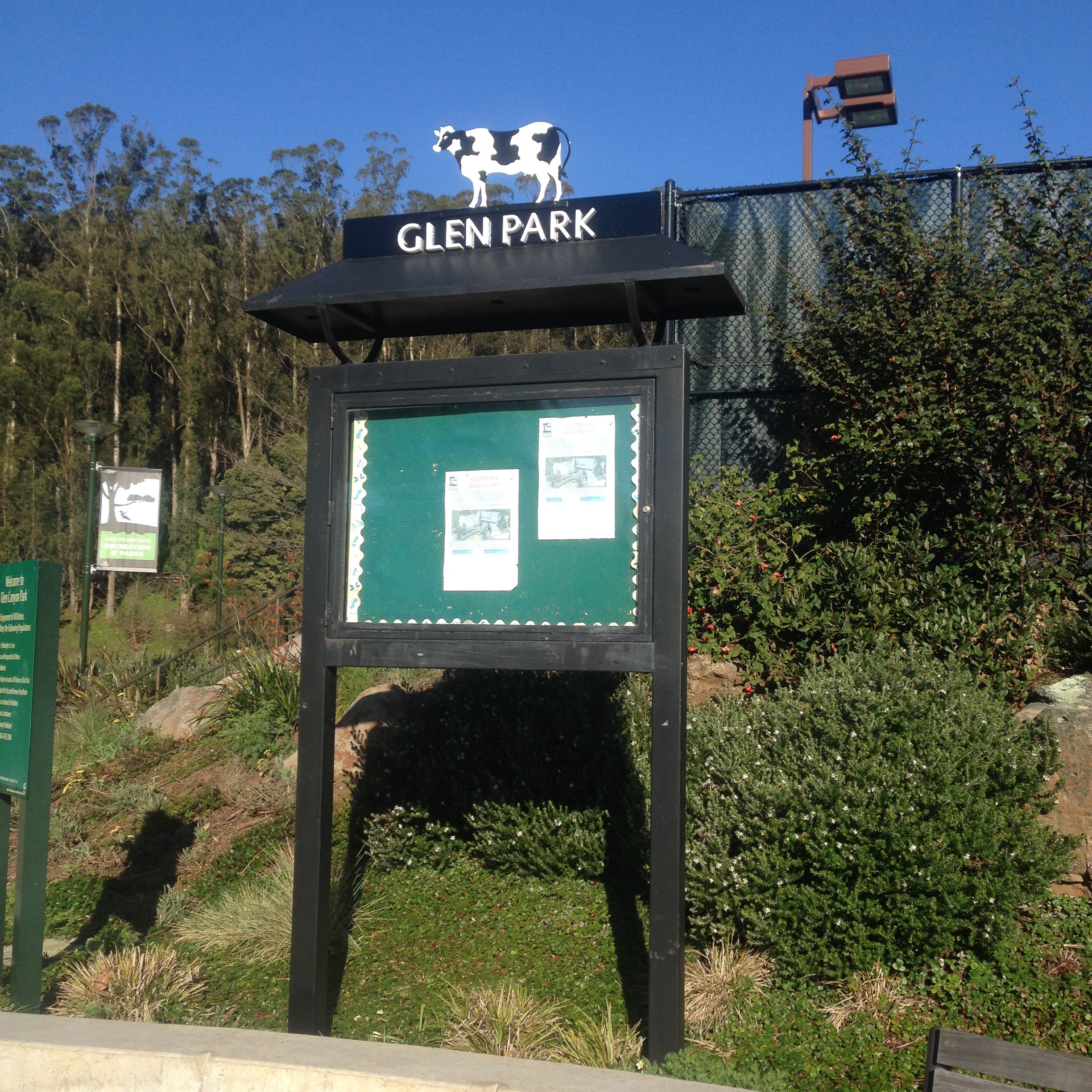
Story and photos by Murray Schneider
On June 10, the public will be invited to the general opening of the refurbished Glen Park Recreation Center from 11:00 – 3:00. After two years of work, the fully renovated space will open to what’s expected to be a big crowd.
On their way in, they’ll hopefully noticed the newly refurbished Holstein dairy cow sign at the entrance to the park, which has been freshly laminated with weather proof paint and burnished with an anti-tagging veneer.
The dairy cow sign, below the Elk Street tennis courts, welcomes park users entering Glen Park’s 70-acre playground and natural area.
The original Glen Park kiosk signs, with cow attached, were created after long-time Glen Canyon Park support Miriam Moss wrote a grant that was funded by Friends of Rec & Park. That same grant paid for the cargo box used by the gardeners to make their work easier.
“But cows? In Glen Park?” you might ask.
Oh yes, very much so. The Holstein’s image signals far more than the park’s entrance – it’s a reminder of the time not so long ago when Glen Park was an important part of San Francisco’s farming ecosystem.
“For a century, the City and County of San Francisco was the hub of the California dairy industry,” writes historian Evelyn Rose in her article “Cows in the City. “The Gold Rush established milk as liquid gold.”
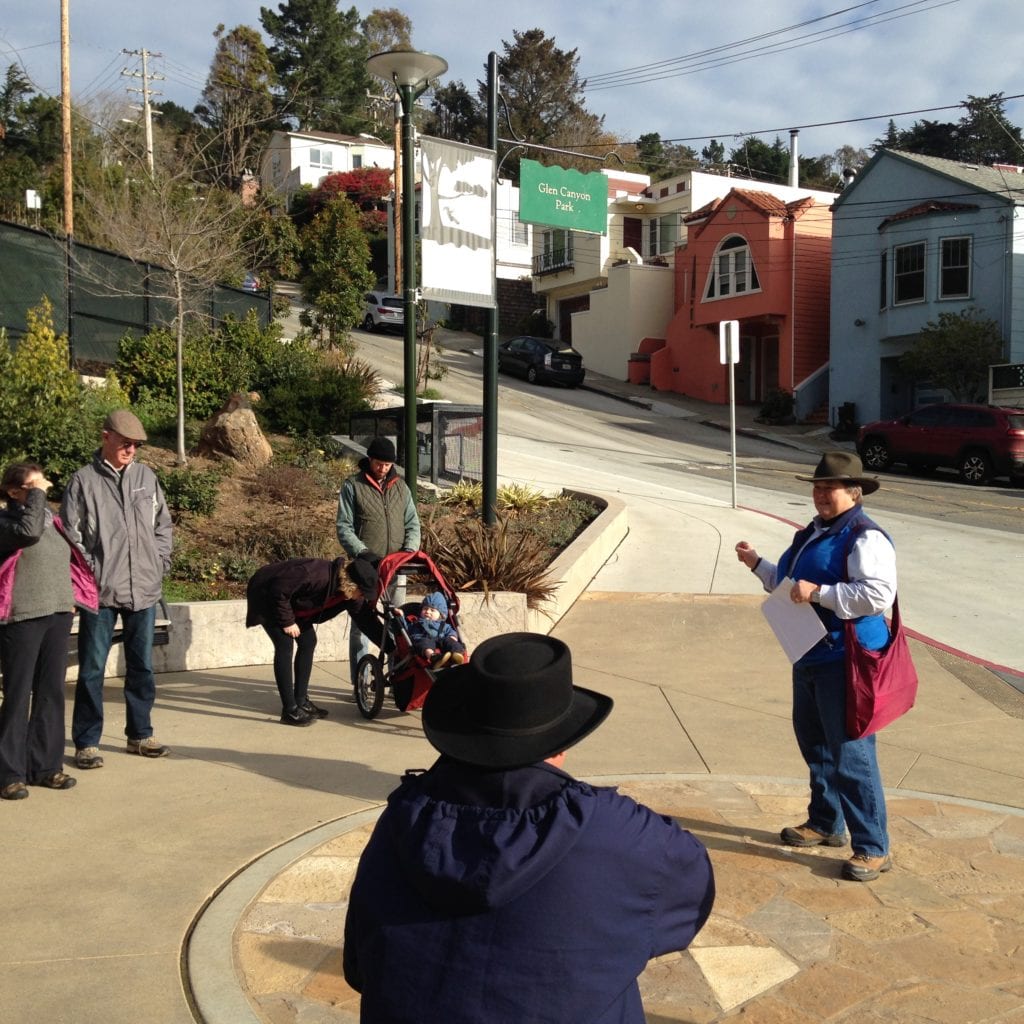
Charles Gough was an early San Francisco milkman and could earn up to $4 a gallon, which would be almost $100 per gallon in today’s currency. Returning Angels Camp placer miners, gold seekers with nuggets in one hand binged on Gough’s milk punch with the other hand.
“They’d make,” Rose writes, “a rum, bandy, sugar, lemon and egg concoction.”
By the 1860s, John Gardiner’s ranch was located in Glen Canyon. He’d graze his cows below present Christopher Playground. Robert Clark had a dairy near today’s remodeled Recreation Center. There were others, too, one owned by George Ulshofer, located near Glen Park Elementary School, and another run by Henry Wilson’s near Diamond and Chenery Streets.
Still another, owned by the Jacob Rick family, was near today’s Chilton and Chenery byways.
Young Old Timers recall the best known local dairy, that of former mayor George Christopher, the Greek-American who engineered the San Francisco Giants leaving the New York Polo Grounds for Seals Stadium in 1958.
As Evelyn Rose emailed the Glen Park News,
Cows owned by the Christopher Dairy – producers of Ronald Reagan’s self-reported favorite milk – ranged along the slopes of Glen Canyon adjacent to O’Shaughnessy Boulevard as late as 1940’s.
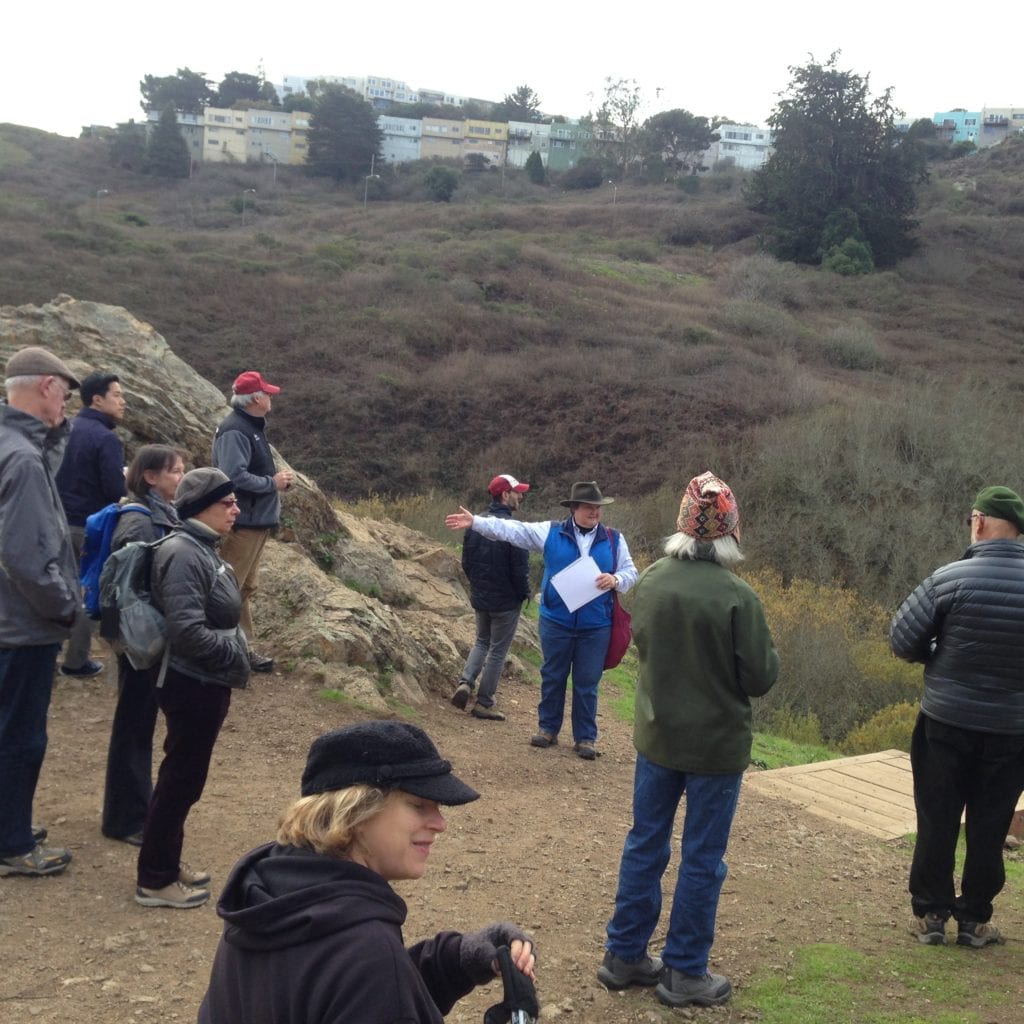
Milk prices didn’t remain at Sierra heights, Rose maintains, leveling off by the turn of the 20th century. In the early morning, Glen Park milch ranchers would leave their spreads, wagoning to what is now Portola Drive, then rattle along Market or Mission Streets, delivering their product to milk factors at the Third and Howard Streets Milkman Exchange.
“By 1875 there were about 150 milk dealers in the City and County of San Francisco,” Evelyn Rose writes in another article, “Why the Cow on the Sign at the Entrance to Glen Canyon?”
And by 1904, Rose writes in “Cows in the City,” “within the City limits there were 4,200 bovine residents producing 13,000 gallons of milk a day.”
Milk was also a cottage industry. Many residents in Glen Park and the Sunnyside kept family cows and could often be seen, Heidi-like, trailing behind their beeves, their arms wind milling, coaxing cows to rerun to hilly Congo or Baden Street barns.
Amy O’Hair is no stranger to such details, as she writes about Sunnyside history in articles such as “Cows in Sunnyside” on her SunnysideHistory.org website.
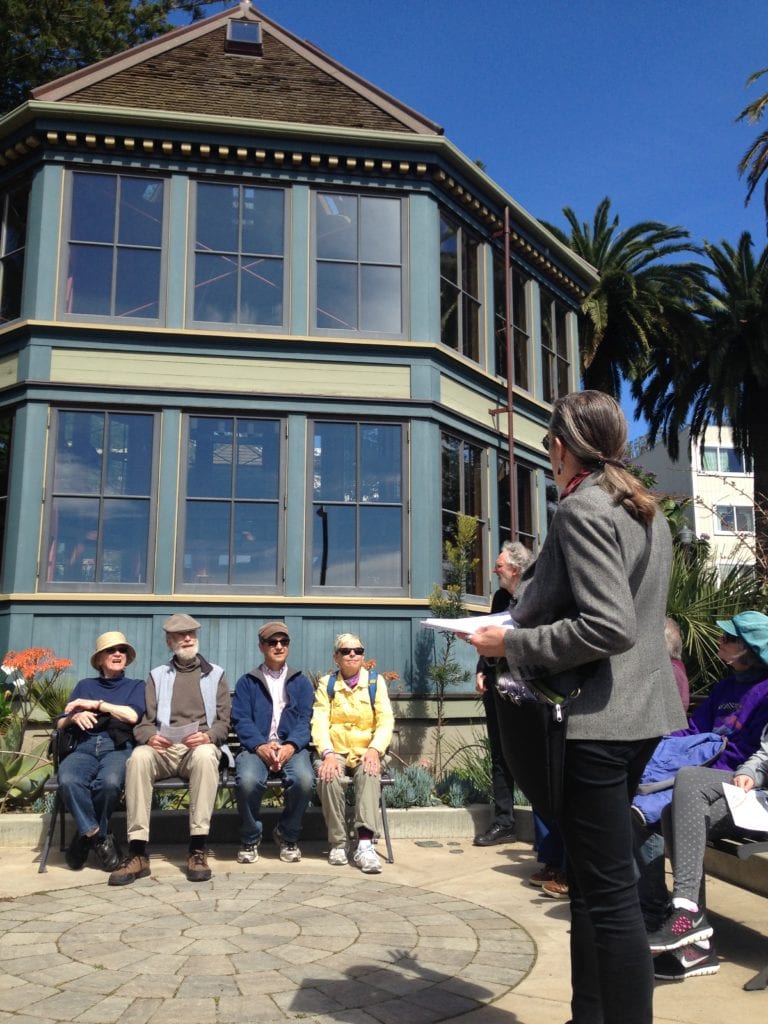
“Cows were allowed to roam and housewives would have to look for them,” O’Hair penned in “Cows in Sunnyside.”
Sunnyside had good grazing, boasting above ground creek water, and by the early 1900s San Francisco had established boundaries within which wandering livestock was allowed to roam. These boundaries, O’Hair writes in “Cows in Sunnyside” were called “the pound limit, a two cow limit.”
Predictably, entrepreneurial dairymen, who kept and bred cows and who sold to dealers that distributed milk within the City, pushed the envelope, lobbying City Hall for exceptions to the double cow limit.
“Lost cows were lost capital,” O’Hair writes in “Cows in Sunnyside,” “and as late as the 1920s Sunnyside residents on the north side were irked by damage done to their gardens from cows that had wandered over the hill from farms near Glen Park.”
The incline was Martha Hill, which today accommodates Dorothy W. Erskine Park.
Dairy ranching wasn’t without hazard, some lethal. Amy O’Hair makes this point in another article, “The Ballad of Ellen Fuery.”
The Southern Pacific ran its railroad tracks from Third and Townsend Streets through the Sunnyside, O’Hair writes, on its way to San Luis Obispo. On a morning in 1896 catastrophe struck when Ellen Fuery, a 52- year old milkmaid, met her end, killed by a barreling train traveling at dangerous speeds through her pastoral neighborhood.
“Fuery took her cows across the tracks for better pasture,” explains O’Hair in “The Ballad of Ellen Fuery.” At the time she was killed she owned five cows and sold milk locally to neighbors and milk dealers.”
Evelyn Rose and Amy O’Hair, the antiquarians behind the Glen Park Neighborhoods History Project, stampede over one another to get to university data bases, historical society archives and century-old municipal maps, better to burn their brands onto debatable facts and interpretations.
These sun-bathed days of yesteryear are their provenance, an era when Sunnyside ruminants renewed themselves on ridges with names such as Manglels and Joost, Martha and Stillings.
Recently, the two women corralled a treat as pleasant as a Sunnyside spring day.
A playmate for the spruced-up Glen Canyon Holstein sign.
They purchased a puppet, a cuddly cow, capable of wrapping its hooves around Amy O’Hair’s fingers.
“I named her Glenda,” said O’Hair, about her huggable puppet.
“Glenda is not exactly a traditional cow name,” opined O’Hair, conjuring images of Elsie and Clo of Borden and Clover billboards. “Glenda’s an old cow who has seen a lot of canyon history.”
Glen Park and Sunnyside may have lost cows to history, but following Miriam Moss’ lead, Evelyn Rose and Amy O’Hair aren’t about to allow history lose memory of neighborhood cows.
They want to share Glenda with Sunnyside and Glen Park future generations.
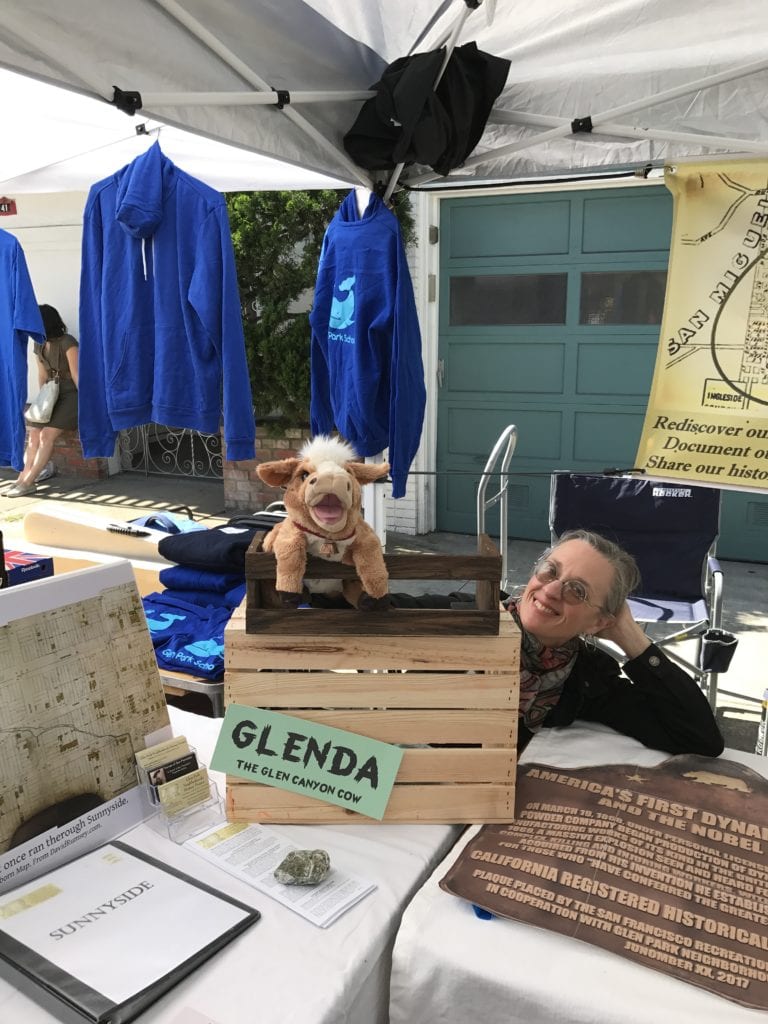
“We used Glenda at this year’s Education Day at the annual San Francisco History Days events at the Old Mint,” emailed O’Hair. “The kids who attended Education Day engaged with Glen Park history through our interactive puppet show.”
“Glenda seemed to work best with kids from about eight to 12,” said O’Hair. “Evelyn and I have a conversation, Evelyn recalling some of the many exciting events in Glen Canyon such as the dynamite factory and the crowds of Sunday visitors in the early 20th century.”
O’Hair bought Glenda from Folkmanis Puppets, a Berkeley company (yes, there are cows in Berkeley, too).
Glenda wasn’t perfect right out of the paddock, though.
“Glenda didn’t have an udder,” said O’Hair about her comfort cow. So she reached for her sewing kit. “I crafted one of fabric and added it.”
*******
Readers who wish to learn more about Glen Park and Sunnyside cows and much more they can sign up for the following walks led by our two neighborhood historians:
“A Trestle Ran Through it: Early Days in the Glen Park Village” led by Evelyn Rose
“Sunnyside History Walk: The Early Years” led by Amy O’Hair – scheduled next on July 8, 2017 – RSVP: SunnysideHistory@gmail.com
“Bovines, Dynamite, and High-Flying Shows: The Amazing History of Glen Canyon Park” led by Evelyn Rose – scheduled next for August 27, 2017–RSVP:GlenParkHistory@gmail.com
Additionally, readers may like to check out the following links:
https://findery.com/Tramps_of_SF/notes/why-the-cow-on-the-sign-at-the-entrance-to-glen-canyon http://www.trampsofsanfrancisco.com/cows-san-francisco/ http://sfhistorydays.org/friday/ sfhistorydays.org http://www.folkmanis.com/17/home.htm sunnysidehistory.org http://glenparkhistory.wixsite.com/glenparkhistory https://sunnysidehistory.org/2016/02/29/the-ballad-of-ellen-furey/ http://opensfhistory.org/Display/wnp14.0995.jpg http://opensfhistory.org/Display/wnp14.0997.jpg http://opensfhistory.org/Display/wnp14.0996.jpg https://sunnysidehistory.org/2015/11/08/cows-in-sunnyside-2/